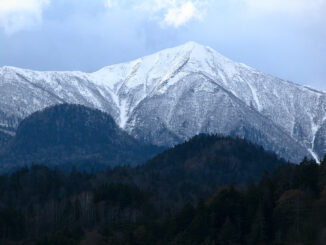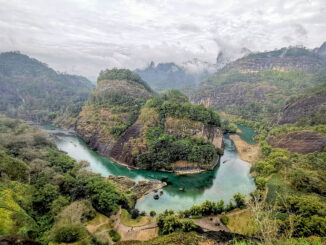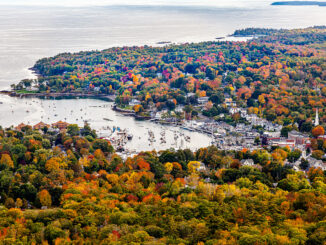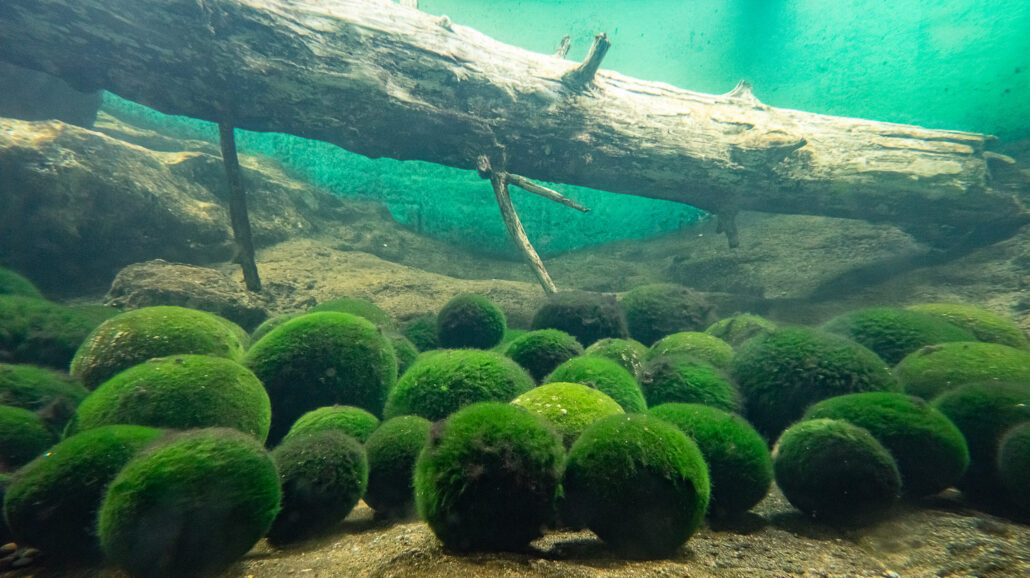
Scientists are scrambling to solve the mystery behind the steady disappearance of one of the world’s rarest and strangest plants.
Marimo is a type of algae found in just a handful of lakes scattered across the world. Normally the species, Aegagropila linnaei, grows in stringy filaments and spends its life attached to rocks, forming an unremarkable mat of green fuzz like underwater moss. But in very rare instances, these A. linnaei grow as unattached, nearly perfectly spherical balls that roll along a lake’s bottom.
The Japanese word “marimo” roughly translates to “ball moss” or “ball algae” in English, and that’s precisely what this strange plant looks like—a completely rootless, fuzzy green ball.
And Lake Akan at Akan-Mashu National Park, a natural wonder in Hokkaido, northern Japan, is one of only four places on Earth where beautifully spherical marimo still occur naturally. The plant is so rare that the Japanese have designated the marimo as a national treasure protected by the Agency for Cultural Affairs.
This algae species is also in rapid decline throughout the world, both the attached kind and especially spherical marimo. And authorities in Hokkaido fear that Japan’s marimo may be next. Lake Akan has now become a focal point of research aimed at saving the species from extinction.
“Until the early 1900s, the spherical type of marimo was reported to be occurring in a wide swath of lakes, including Lake Zell in Austria,” said Oyama Yoichi, a researcher and curator at the Marimo Research Laboratory at Lake Akan, Hokkaido. “But today, they’re only found in places like Lake Mývatn in Iceland and at Lake Akan.”
The mystery behind the marimo’s decline
Eutrophication caused by excess nutrient loading into lakes has been deemed to be the likeliest culprit behind the marimo’s global decline, especially in Europe. Cyanobacteria blooms turn lakes murky, blocking the sunlight that keeps the algae alive.
But eutrophication is typically linked to fertilizers used in agriculture. Marimo is vanishing even in places relatively unaffected by any neighboring agricultural activity, such as the lakes of northern Iceland and Akan Lake in eastern Hokkaido. Árni Einarsson, director of the Mývatn Research Station, acknowledged the discrepancy and lingering mystery.
“Cyanobacteria blooms in general follow human-derived nutrients, eutrophication, and climate warming,” said Einarsson, director of the Mývatn Research Station in Iceland, in an email exchange. “But for each particular lake, it is difficult to say exactly what is a causal factor when things change. This is partly because ecosystem changes tend to be stepwise rather than gradual.”
Whatever the connection, scientists worry that marimo are still disappearing.
A 2010 study led by researchers at Leiden University in the Netherlands concluded that the worldwide population of spherical marimo declined by almost 60 percent over 30 years. In 57 percent of lakes previously known to have hosted even just the stringy attached form of marimo the species hasn’t been seen at all in decades, that same study noted.
Spherical marimo were first discovered in Lake Zell in Austria, but long ago disappeared from that lake. Today, experts say the ball form of marimo can be detected in just four places: Lake Akan, in northern Iceland, at a lake in Estonia, and another lake in northwestern Ukraine near the border with Poland.
“For several locations, this species is already assumed or known to be extinct,” noted the authors of that 2010 study, published in the journal BioScience. “In four out of the five locations in the Netherlands where A. linnaei was found 60 years ago, it is now absent, and the unattached forms seem to have disappeared altogether as a result of the effects of eutrophication.”
In 2014, Einarsson penned a “Memoriam” in which he declared the spherical marimo of northern Iceland largely extinct. He later confirmed that the ball form of this algae species still occurs in Lake Mývatn, but much less often than it had in the past, and not nearly to the extent that marimo grows in northern Japan.
“The large, around 12 centimeters [in diameter], marimo is no longer present in Lake Mývatn,” he said. “Colonies of small marimo, around 3 cm, have been found in recent years in a few new places in the lake but their extent is not known.” Thus, conservationists are closely following events at Lake Akan in light of the rapid global decline of the species. “Lake Akan is the most important target of conservation efforts,” the Netherlands study confirmed.
“Even in Lake Mývatn, since 2013 their status has deteriorated and they are disappearing,” Oyama explained. “Today you can still occasionally see them there, but their numbers have plunged dramatically. Now Lake Akan is considered the only place in the world where they can occur in large concentrations.”
Eastern Hokkaido – A beautiful home for marimo
Akan-Mashu National Park in eastern Hokkaido is about an hour’s drive north of the city of Kushiro. A stunning landscape of active and dormant volcanoes, hot springs, and dense forests, the park is home to three of Japan’s most famous lakes: Mashu, Kussharo, and Akan. But it’s only in Lake Akan where you’ll find the park’s marimo colonies.
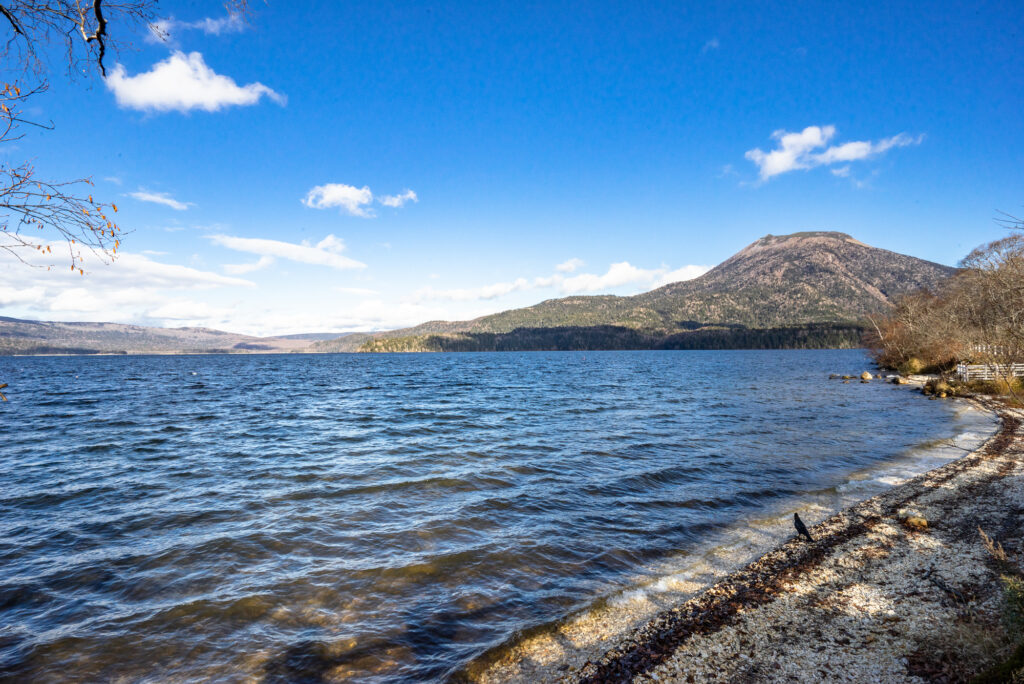
Among A. linnaei research circles, Lake Akan is famous both for its large population of spherical marimo and for the huge size they can grow to.
Researchers in Iceland seem pleased to be able to find sufficient numbers of ball marimo 3 cm in diameter or greater, roughly the size of golf balls. During an interview at his lab, Oyama presented a dried specimen from Lake Akan that was easily the size of a soccer ball. The specimen had been cut in half to demonstrate how the center turns hollow as a marimo reaches a certain girth.
They get even bigger, he said. The official record holder was 34 cm in diameter, about 30 percent larger than a basketball. “Older records describe marimo that were 40 centimeters in size, but the greatest officially confirmed size is 34 centimeters,” Oyama said.
Spherical marimo forms slowly. Researchers think they grow only about 1 centimeter per year and can take up to seven years to get as large as a baseball. Einarsson said their growth is limited by variable light intensity.
Pieces of the algae come detached from rocks but still thrive in this free-floating condition, gradually clumping together. They then grow into near-perfect spheres due to the way wave action rotates them on a lake bottom, gradually exposing all sides to equal amounts of sunlight.
Even this mechanism remained something of a mystery for a long time–it wasn’t until 2015 when scientists at Kobe University and the Kitami Institute of Technology confirmed that lake waves are the force behind the creation of spherical marimo. The researchers used an underwater camera to match marimo rotations with wave strength and wind speeds.
Einarsson argued that Japan’s conservationists have been successful in preserving their marimo colonies because they’ve kept Lake Akan cleaner. “They have managed to lower the density of cyanobacteria, resulting in clearer water and much larger marimo,” he explained.
However, Oyama is worried that lake conditions at Akan are rapidly turning hostile for the marimo. He warns that the plant’s extent in Lake Akan has declined, as well. For instance, the marimo used to be found in abundance at a bay on the western corner of the lake, he said, but today they only form in the lake’s northernmost section where the waves are strongest. The area is accessible only by boat from the lake’s southern shores. Visitors are treated to an interpretive center where marimo specimens can be observed in aquariums.
Other threats to the marimo’s survival
Japan’s fuzzy green balls are also facing greater competition for sunlight. Lake Akan has seen explosive growth in lake grass in recent years. Oyama said, and this normally wouldn’t be a problem except for the fact that the grasses are encroaching on the marimo’s lake territory.
Not only could it block sunlight, but the encroaching grasses can also weaken wave action, thus physically preventing ball marimo from rolling along the bottom and growing larger. Dead grass is also washing up on the lake shore and steadily forming new land, Oyama said, slightly shrinking the total area of Lake Akan.
Scientists have also raised concerns over poaching, but don’t believe that explains the decline of marimo. Access to wild marimo is heavily restricted. The authorities even closed a road running to Lake Akan’s north shore to further protect the species.
Souvenir hunters were a problem at Akan in the 1980s before officials cracked down on the practice. Poaching may still pose a future threat. The 2010 study out of the Netherlands noted that some high-end customers acquired marimo for use in aquariums in legally-questionable sales. But researchers have dismissed poaching as a likely cause of the rapid fall in marimo numbers worldwide.
Oyama says he’s turned his attention to climate change. “Just surveying where the marimo occur, we can see that they are generally not found in warmer countries,” he pointed out.
Because spherical marimo only grow in certain lake conditions at higher latitudes of the Northern Hemisphere, Oyama and other marimo experts naturally worry that rising global temperatures may pose a threat. But they have yet to uncover any evidence that this is so. Climate change and marimo disappearance are only correlated temporally. Proof of causation doesn’t exist, Oyama cautioned. Still, investigations are underway to study how temperature changes may be affecting this unique and rare plant.
Oyama said investigations conducted by other scientists show that a water temperature of around 22 degrees Celsius, or 71 degrees Fahrenheit, seems ideal for the string form of the algae species to grow and thrive. Growth rates improve as water temperatures move higher from 8 degrees to 22 degrees Celsius. The species can still survive in waters 30 degrees Celsius “but any warmer than that isn’t good” he said.
Oayama said research shows that marimo will collapse and die within 24 hours in water that is 35 degrees Celsius, or about 95 degrees Fahrenheit. He doubts the waters of Lake Akan could ever reach that temperature, but he nevertheless worries that average temperatures in the lake may be rising. He is taking hourly temperature readings to determine if this occurring.
Though temperature variations are now under his scrutiny, Oyama repeatedly cautioned that no link between marimo decline and global warming has yet been determined. Einarsson concurred.
When he’s not kept busy removing tons of grass from the lake bottom, Oyama says he spends a lot of time monitoring the lake for temperature changes and diving to inspect the marimo, investigating what these changes might be doing to them. For now, the mystery endures.
“We are extremely interested in what happens to the marimo as temperatures increase” due to global warming, he said. “You certainly can’t say that there isn’t any impact.”
©Public Parks
Park Info
Park Name:
Akan-Mashu National Park
Location:
Hokkaido, Japan
More information:

